Grace Elliot's Blog: 'Familiar Felines.' , page 22
August 8, 2012
Dead Cats and Commercialism - London Trivia #3
Today's tale of London trivia tells how the exclusive shopping venue, the Burlington Arcade, Piccadilly came into being.
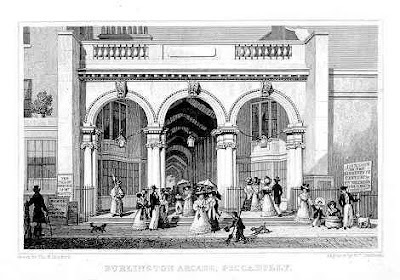 The original triple arch entrance to the Burlington Arcade.For those unfamiliar with London, the Burlington Arcade is a parade of high-end shops housed in Georgian splendour, beside the current home of the Royal Academy, Burlington House. However, did you know that in 1819 these Georgian shops came into existence to stop dead cats falling on Lord Cavendish when he sat in his garden?
The original triple arch entrance to the Burlington Arcade.For those unfamiliar with London, the Burlington Arcade is a parade of high-end shops housed in Georgian splendour, beside the current home of the Royal Academy, Burlington House. However, did you know that in 1819 these Georgian shops came into existence to stop dead cats falling on Lord Cavendish when he sat in his garden?
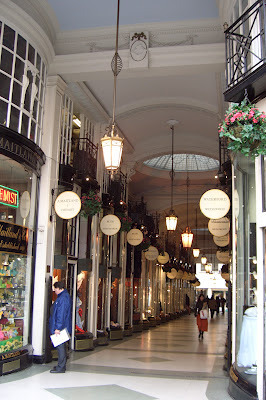 Interior of the Burlington Arcade today. In the early 19th century Lord George Cavendish was the owner of Burlington House. But no matter how splendid his residence, Lord Cavendish derived little pleasure from sitting outside because of a constant rain of oyster shells, apple cores, bottles and even the odd dead animal. This was because an alleyway ran alongside his property and the passers-by liked to lob their rubbish over his garden wall.
Interior of the Burlington Arcade today. In the early 19th century Lord George Cavendish was the owner of Burlington House. But no matter how splendid his residence, Lord Cavendish derived little pleasure from sitting outside because of a constant rain of oyster shells, apple cores, bottles and even the odd dead animal. This was because an alleyway ran alongside his property and the passers-by liked to lob their rubbish over his garden wall.
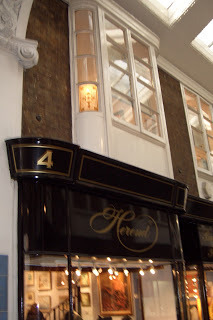 The Burlington Arcade - interior.Cavendish's solution was to commission Samuel Ware to design a arcade of small shops in the alleyway, and do away with the nuisance of the uncouth public dumping their rubbish over his wall. The result was the Burlington Arcade, which still exists as a retail mall to this day. Opened on 20th March, 1819, the mall reputedly cost 49,000 pounds to build, rent for a single unit was a little over 12 pounds a year. One of the first lease holders was patronised by the Prince Regent to supply gold lace for his uniforms.
The Burlington Arcade - interior.Cavendish's solution was to commission Samuel Ware to design a arcade of small shops in the alleyway, and do away with the nuisance of the uncouth public dumping their rubbish over his wall. The result was the Burlington Arcade, which still exists as a retail mall to this day. Opened on 20th March, 1819, the mall reputedly cost 49,000 pounds to build, rent for a single unit was a little over 12 pounds a year. One of the first lease holders was patronised by the Prince Regent to supply gold lace for his uniforms.
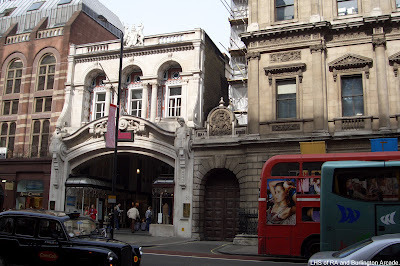 The Burlington Arcade to the left and the edge of the Royal Academy to the right.Originally a single storey building, an upper level was added in 1906 with apartments to let (as one wit put it, "To a better sort of courtesan".) The original triple arch entrance was removed in 1931 and a new design added, which was much disliked at the time. The shops are small but famous for selling expensive, luxury goods - hence quality over quantity.
The Burlington Arcade to the left and the edge of the Royal Academy to the right.Originally a single storey building, an upper level was added in 1906 with apartments to let (as one wit put it, "To a better sort of courtesan".) The original triple arch entrance was removed in 1931 and a new design added, which was much disliked at the time. The shops are small but famous for selling expensive, luxury goods - hence quality over quantity.
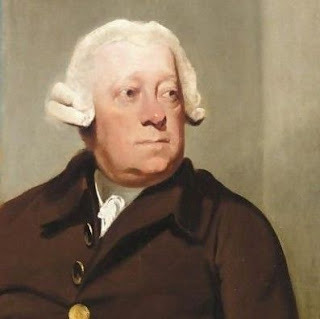 Lord George Augustus Cavendish. A beadle (the Georgian equivalent of a security man) patrolled the mall in order to stop the 'wrong sort' entering. The first beadles were recruited from the Cavendish family regiment of the 10th Hussars to enforce a strict code of conduct within the arcade which included: no running, whistling or playing musical instruments, no carrying large parcels and no babies' prams. In the 19th century the beadle had a leather armchair at the entrance on which to sit whilst keeping an eye on visitors. It was also the beadle's job to ring a hand-bell to tell the shops to close. To this day there is still a team of four beadles(but no chair) and they have the authority to eject you from the arcade if behaving inappropriately.
Lord George Augustus Cavendish. A beadle (the Georgian equivalent of a security man) patrolled the mall in order to stop the 'wrong sort' entering. The first beadles were recruited from the Cavendish family regiment of the 10th Hussars to enforce a strict code of conduct within the arcade which included: no running, whistling or playing musical instruments, no carrying large parcels and no babies' prams. In the 19th century the beadle had a leather armchair at the entrance on which to sit whilst keeping an eye on visitors. It was also the beadle's job to ring a hand-bell to tell the shops to close. To this day there is still a team of four beadles(but no chair) and they have the authority to eject you from the arcade if behaving inappropriately.
 Widget- because she's cute...and I wouldnt want her falling on my head! So finally, if you visit the longest covered street in Britain, spare a thought for the Burlington Arcade's original reason for being - to stop dead cats falling on Lord Cavendish's head!
Widget- because she's cute...and I wouldnt want her falling on my head! So finally, if you visit the longest covered street in Britain, spare a thought for the Burlington Arcade's original reason for being - to stop dead cats falling on Lord Cavendish's head!

 The original triple arch entrance to the Burlington Arcade.For those unfamiliar with London, the Burlington Arcade is a parade of high-end shops housed in Georgian splendour, beside the current home of the Royal Academy, Burlington House. However, did you know that in 1819 these Georgian shops came into existence to stop dead cats falling on Lord Cavendish when he sat in his garden?
The original triple arch entrance to the Burlington Arcade.For those unfamiliar with London, the Burlington Arcade is a parade of high-end shops housed in Georgian splendour, beside the current home of the Royal Academy, Burlington House. However, did you know that in 1819 these Georgian shops came into existence to stop dead cats falling on Lord Cavendish when he sat in his garden? Interior of the Burlington Arcade today. In the early 19th century Lord George Cavendish was the owner of Burlington House. But no matter how splendid his residence, Lord Cavendish derived little pleasure from sitting outside because of a constant rain of oyster shells, apple cores, bottles and even the odd dead animal. This was because an alleyway ran alongside his property and the passers-by liked to lob their rubbish over his garden wall.
Interior of the Burlington Arcade today. In the early 19th century Lord George Cavendish was the owner of Burlington House. But no matter how splendid his residence, Lord Cavendish derived little pleasure from sitting outside because of a constant rain of oyster shells, apple cores, bottles and even the odd dead animal. This was because an alleyway ran alongside his property and the passers-by liked to lob their rubbish over his garden wall.
 The Burlington Arcade - interior.Cavendish's solution was to commission Samuel Ware to design a arcade of small shops in the alleyway, and do away with the nuisance of the uncouth public dumping their rubbish over his wall. The result was the Burlington Arcade, which still exists as a retail mall to this day. Opened on 20th March, 1819, the mall reputedly cost 49,000 pounds to build, rent for a single unit was a little over 12 pounds a year. One of the first lease holders was patronised by the Prince Regent to supply gold lace for his uniforms.
The Burlington Arcade - interior.Cavendish's solution was to commission Samuel Ware to design a arcade of small shops in the alleyway, and do away with the nuisance of the uncouth public dumping their rubbish over his wall. The result was the Burlington Arcade, which still exists as a retail mall to this day. Opened on 20th March, 1819, the mall reputedly cost 49,000 pounds to build, rent for a single unit was a little over 12 pounds a year. One of the first lease holders was patronised by the Prince Regent to supply gold lace for his uniforms.
 The Burlington Arcade to the left and the edge of the Royal Academy to the right.Originally a single storey building, an upper level was added in 1906 with apartments to let (as one wit put it, "To a better sort of courtesan".) The original triple arch entrance was removed in 1931 and a new design added, which was much disliked at the time. The shops are small but famous for selling expensive, luxury goods - hence quality over quantity.
The Burlington Arcade to the left and the edge of the Royal Academy to the right.Originally a single storey building, an upper level was added in 1906 with apartments to let (as one wit put it, "To a better sort of courtesan".) The original triple arch entrance was removed in 1931 and a new design added, which was much disliked at the time. The shops are small but famous for selling expensive, luxury goods - hence quality over quantity.  Lord George Augustus Cavendish. A beadle (the Georgian equivalent of a security man) patrolled the mall in order to stop the 'wrong sort' entering. The first beadles were recruited from the Cavendish family regiment of the 10th Hussars to enforce a strict code of conduct within the arcade which included: no running, whistling or playing musical instruments, no carrying large parcels and no babies' prams. In the 19th century the beadle had a leather armchair at the entrance on which to sit whilst keeping an eye on visitors. It was also the beadle's job to ring a hand-bell to tell the shops to close. To this day there is still a team of four beadles(but no chair) and they have the authority to eject you from the arcade if behaving inappropriately.
Lord George Augustus Cavendish. A beadle (the Georgian equivalent of a security man) patrolled the mall in order to stop the 'wrong sort' entering. The first beadles were recruited from the Cavendish family regiment of the 10th Hussars to enforce a strict code of conduct within the arcade which included: no running, whistling or playing musical instruments, no carrying large parcels and no babies' prams. In the 19th century the beadle had a leather armchair at the entrance on which to sit whilst keeping an eye on visitors. It was also the beadle's job to ring a hand-bell to tell the shops to close. To this day there is still a team of four beadles(but no chair) and they have the authority to eject you from the arcade if behaving inappropriately.
 Widget- because she's cute...and I wouldnt want her falling on my head! So finally, if you visit the longest covered street in Britain, spare a thought for the Burlington Arcade's original reason for being - to stop dead cats falling on Lord Cavendish's head!
Widget- because she's cute...and I wouldnt want her falling on my head! So finally, if you visit the longest covered street in Britain, spare a thought for the Burlington Arcade's original reason for being - to stop dead cats falling on Lord Cavendish's head!
Published on August 08, 2012 02:12
August 1, 2012
London Trivia #2 - Where is the centre of London?
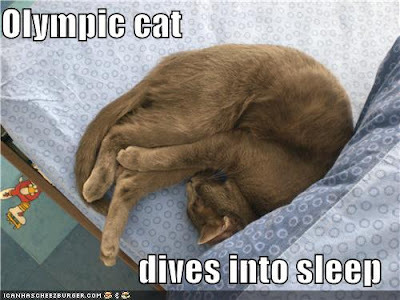 Photo courtesy of Cheezburger.comTo celebrate London2012, in this second post of historical trivia I attempt to answer the question: where is the centre of the capital? I had some vague notion that the statue of Eros at Piccadilly Circus marked the spot, but it turns out I am wrong! Neither is it Buckingham Palace or St Paul's Cathedral…so where is it?
Photo courtesy of Cheezburger.comTo celebrate London2012, in this second post of historical trivia I attempt to answer the question: where is the centre of the capital? I had some vague notion that the statue of Eros at Piccadilly Circus marked the spot, but it turns out I am wrong! Neither is it Buckingham Palace or St Paul's Cathedral…so where is it? Buckingham Palace from the air- photo Thomas Nugent.The actual spot is marked by a brass plaque in what was medieval Charing Cross (more of this later), near the currentTrafalgar Square and the equestrian statue of King Charles I.
Buckingham Palace from the air- photo Thomas Nugent.The actual spot is marked by a brass plaque in what was medieval Charing Cross (more of this later), near the currentTrafalgar Square and the equestrian statue of King Charles I. 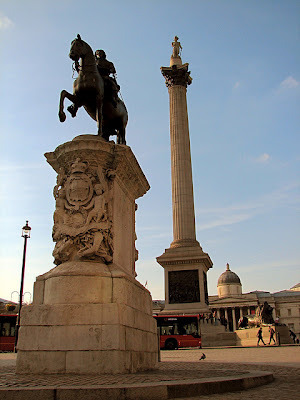 Statue of Charles I , southern corner of Trafalgar Square.To find out why this spot is defined as the centre of London we need to go back to the 11th century and the time of Edward the Confessor. Edward was one of the last Anglo-Saxon kings (reigning 1042 - 1066) and he pledged to go on a pilgrimage to Rome, but civil unrest meant he couldn’t leave his kingdom. In recompense for breaking his vow he decided to build a large church. He chose an area of high ground near the marshes of the Thames, demolished the existing monastery and started building that which later became Westminster Abbey.
Statue of Charles I , southern corner of Trafalgar Square.To find out why this spot is defined as the centre of London we need to go back to the 11th century and the time of Edward the Confessor. Edward was one of the last Anglo-Saxon kings (reigning 1042 - 1066) and he pledged to go on a pilgrimage to Rome, but civil unrest meant he couldn’t leave his kingdom. In recompense for breaking his vow he decided to build a large church. He chose an area of high ground near the marshes of the Thames, demolished the existing monastery and started building that which later became Westminster Abbey.  Edward the Confessor, depicted in the Bayeux tapestry.However merchants in the old city of Londonconsidered it an unreasonable distance to travel to Westminsterand the new seat of authority, and so when traders wanted to hear the latest government policy they met at a half way point - Charing Cross. It is this spot, marked by the brass plaque and is still the official centre of London, so much so that people working within a 6 mile radius can claim London-weighting for their expenses and are entitled to extra payments.
Edward the Confessor, depicted in the Bayeux tapestry.However merchants in the old city of Londonconsidered it an unreasonable distance to travel to Westminsterand the new seat of authority, and so when traders wanted to hear the latest government policy they met at a half way point - Charing Cross. It is this spot, marked by the brass plaque and is still the official centre of London, so much so that people working within a 6 mile radius can claim London-weighting for their expenses and are entitled to extra payments.
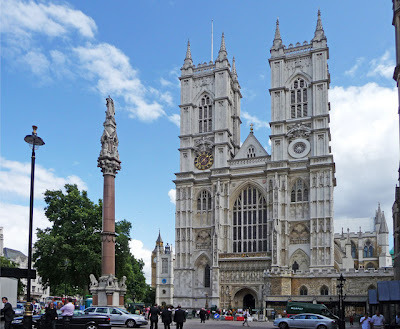 Westminster Abbey - built of the site of Edward's church. Photo Karen Matthews.And finally, I mentioned medieval Charing Cross, near Trafalgar Square, a short distance from the modern Charing Cross. The original spot was marked by the memorial cross erected by King Edward in 1290, to mark the route of his beloved wife's, Queen Eleanor, funeral procession. The giant cross became such landmark that when the new Charing Cross railway station was opened in 1865, to drum up publicity the original monument was removed and a new and grander memorial erected beside the station to establish a landmark.
Westminster Abbey - built of the site of Edward's church. Photo Karen Matthews.And finally, I mentioned medieval Charing Cross, near Trafalgar Square, a short distance from the modern Charing Cross. The original spot was marked by the memorial cross erected by King Edward in 1290, to mark the route of his beloved wife's, Queen Eleanor, funeral procession. The giant cross became such landmark that when the new Charing Cross railway station was opened in 1865, to drum up publicity the original monument was removed and a new and grander memorial erected beside the station to establish a landmark.  Charing Cross station - from the London Eye. Photo Mike McMillan.
Charing Cross station - from the London Eye. Photo Mike McMillan.
Published on August 01, 2012 01:28
July 25, 2012
London Trivia - #1 - Pavements.
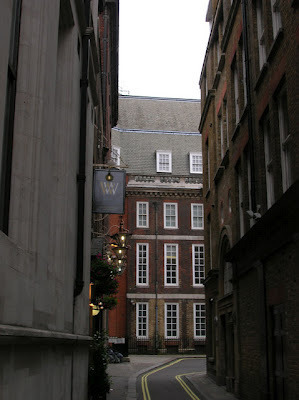 Craig's Court, London - photo courtesy of R Sones.To celebrate the arrival of the London Olympics 2012, I'm starting a short series of blog posts about the more unusual aspects of London's history. Let's start with the story of how pavements came to become common place in the capital.
Craig's Court, London - photo courtesy of R Sones.To celebrate the arrival of the London Olympics 2012, I'm starting a short series of blog posts about the more unusual aspects of London's history. Let's start with the story of how pavements came to become common place in the capital. Before the mid 1750's the pedestrian was much neglected! Roads occupied the total width of the street between the buildings on either side. Most of the roads were also very narrow and it was incredibly dangerous for anyone on foot because on coming vehicles could crush them against a wall. Like a lot of things, it took someone of power and influence to be inconvenienced before anything was done to solve the problem.
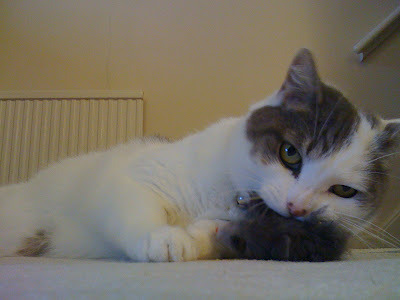 Widget says: "Do what I say or the toy gets it!"
Widget says: "Do what I say or the toy gets it!"This person was the Speaker of the House of Commons, Mr Speaker Onslow. One day in the early 1760's he set off to visit the Earl of Harrington at home in his large house in a small square just off Craig's Court, London. Harrington's house was approached by a narrow alleyway (see header photo) and as Onslow pushed on in a large, stately carriage, the wheels stuck fast to the houses on either side. It was jammed so tightly that the coach's doors couldn’t be opened and Mr Speaker Onslow became a prisoner inside his own vehicle. After many fruitless attempts to move the vehicle the humiliated Speaker was rescued by cutting a hole in the roof of the carriage and pulling him out that way.
Carriage photo courtesy of John Lloyd. On his return to parliament Onslow helped institute a bill decreeing that all householders must pay for a row of kerbstones in front of their property, to warn and thereby stop drivers progressing before they got stuck. Once the kerbstones marked a boundary to show the limit of a road's width, pavements evolved on the building side as a safer place for pedestrians to walk.
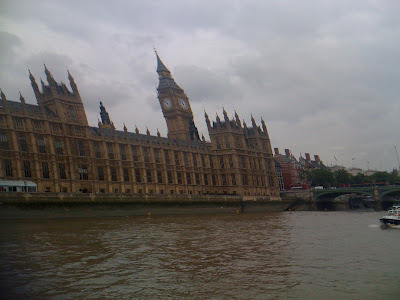 The modern day House of Commons, as seen from the Thames.
The modern day House of Commons, as seen from the Thames.And finally, a black market in kerbstones developed with the unscrupulous stealing them to use themselves in front of their home or to sell on. Since the Admiralty was also duty bound under the pavement act of 1762 to provide kerb stones, they marked them with an arrow to discourage theft. The arrow was a traditional mark introduced by ElizabethI to denote army and navy property, and apparently is still used today for this purpose.
 Kerbstone marked with an arrow - courtesy of Roger Templeman.
Kerbstone marked with an arrow - courtesy of Roger Templeman.
Published on July 25, 2012 07:50
July 18, 2012
Horse Play - Smuggling #5

Have you ever seen a horse acting suspiciously?
Well that’s exactly what 18th century revenue officers were on the look out for!Smugglers, once their contraband was ashore had to transport it inland for sale, and for this they needed horse power. Some gangs used equines employed in legitimate trade as cover for owning large numbers of horses. An example were the horses of the North Kent Seasalter company: by day they shifted timber from the Forest of Blean to the local tanneries, and by night transported contraband inland. A smuggling gang on Romney Marsh also owned horses, but set them to graze in groups of two or three to attract less attention, but when rounded up could raise a caravan up to 200 beasts strong.

The free-traders were notoriously cunning and this extended to their horses. Stories exist of smugglers shaving their horses and soaping or oiling them, to make it more difficult for the excise men to capture them. These horses were highly trained and their cunning masters also taught them to stop on the command "Gee-up" and bolt when told "Woah!"
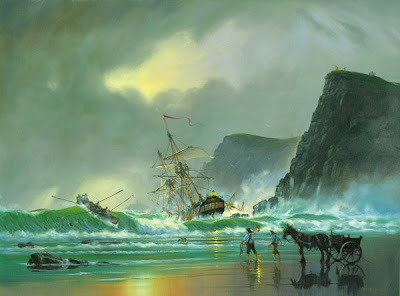
Many of these horses could also find their own way home. This came in handy with the nag loaded with contraband, leaving the smuggler free to create a diversion for any prying eyes. The horse, carrying illicit barrels, found his way back to the stable where a conspirator waited to unload. A variation on this story was one horse who became disoriented by the alcoholic vapours eminating from the tubs strapped to his back, and wandered to his neighbour's house - who happened to be a customs officer. The officer, alerted by the sound of hooves, impounded the contraband and then followed the now unladen horse as he found his way back to the correct house.
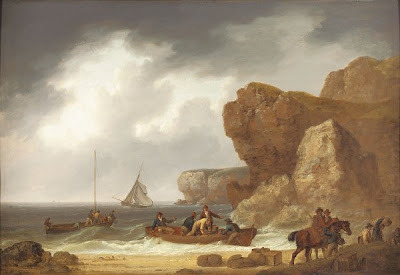
Another way of obtaining horsepower was to have an agreement with local farmers. In Great Holland, one particular farmer was fond of drinking spirits and left his gate unlocked when his barrel was running low, as a sign that his horses could be used in return for a tub of gin or brandy.
 "I know he's around here somewhere...."However this cosy arrangement did not always run smoothly. A winded or exhausted horse was no use for farm work, but to refuse smugglers the priviledge of 'borrowing' a horse could result in a campaign of intimidation. Akin to a modern protection racquet, those who didn’t co-operate found hayricks catching fire, sheep falling ill, or on one occaision a farmer returning from market was unseated from his horse by a cord stretched between two trees across the road.
"I know he's around here somewhere...."However this cosy arrangement did not always run smoothly. A winded or exhausted horse was no use for farm work, but to refuse smugglers the priviledge of 'borrowing' a horse could result in a campaign of intimidation. Akin to a modern protection racquet, those who didn’t co-operate found hayricks catching fire, sheep falling ill, or on one occaision a farmer returning from market was unseated from his horse by a cord stretched between two trees across the road. 
In my latest release, our heroine, Hope Tyler falls foul of a smuggler bent on revenge...find out how and why by reading 'Hope's Betrayal'.
Published on July 18, 2012 01:49
July 11, 2012
A Place of Safety - Smuggling #4
 'A dreadful thing from the cliff did spring.' - Old Norfolk folk taleFrom ghostly dogs to hidden chambers under dung heaps - smugglers were very resourceful at hiding contraband and truth being stranger than fiction, in the 18th century methods of concealment were many and varied indeed. Hiding contraband liquor in a pub cellar was an obvious a solution except that the smaller kegs used by smugglers were easy to spot. However, the landlord of the 16th century 'Spread Eagle' pub was one step ahead; his tavern possessed a concealed well, accessible only from the roof, the shaft of which provided an excellent hiding place. Failing that, there are many tales of landlord's wives in their voluminous skirts, sitting on top of barrels to hide them whilst the revenue man made his rounds.
'A dreadful thing from the cliff did spring.' - Old Norfolk folk taleFrom ghostly dogs to hidden chambers under dung heaps - smugglers were very resourceful at hiding contraband and truth being stranger than fiction, in the 18th century methods of concealment were many and varied indeed. Hiding contraband liquor in a pub cellar was an obvious a solution except that the smaller kegs used by smugglers were easy to spot. However, the landlord of the 16th century 'Spread Eagle' pub was one step ahead; his tavern possessed a concealed well, accessible only from the roof, the shaft of which provided an excellent hiding place. Failing that, there are many tales of landlord's wives in their voluminous skirts, sitting on top of barrels to hide them whilst the revenue man made his rounds. A less obvious hiding place was the church. Situated on Romney Marsh, Snargate Church had a crypt that was used for storing tobacco. Indeed, on one occasion in a thick fog, the vicar was able to safely find his way to the church by following the strong smell of tobacco! Apparently the nave of Snargate Church is decorated with a painting of a ship, which is an early smugglers symbol, code for a place of safety.
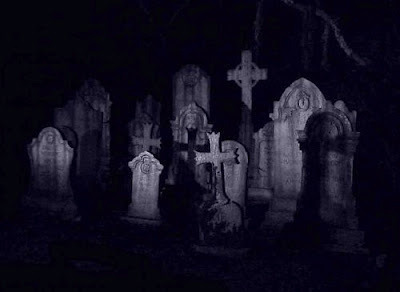
Another church hiding place was the ceiling void, although this wasn’t always without consequence. During Sunday service at Langton Matravers, the choir was singing a psalm when the roof collapsed and kegs rained down on the congregation. Some tricks were inventive, such as having a fire-proof void beneath a hearth. When the revenue men called a fire was lit on top of the hidden chamber to prevent detection. A similar idea was using a cellar hidden beneath a dung heap. The dung was moved aside to reveal a trap door, the contraband concealed, the manure replaced and a herd of sheep driven past to cover the footprints. However in the case, tragedy resulted. When the gang went to retrieve their goods, they failed to listen to warnings about letting the foul air in the cellar clear before going in. Three men were overcome by fumes, two of whom died as a result.
 Moonrakers. Another place was a false partition in a stable - with the addition a vicious horse guaranteed to kick any intruders. In some villages smuggled goods were weighted down and thrown into the village pond, to be retrieved at a more convenient time. When revenue men came across villagers in Bishops Canning, Wiltshire, trawling the pond with line and hook, they demanded to know what was going on. The villager pointed to the moon's reflection and said he was trying to recover, "The big yellow cheese". This trick earned them the nickname of "Moonrakers." In true British humour the inhabitants of Bishops Canning reveled in their new notoriety and even spread rumours that they put manure around the church tower to make it grow taller.
Moonrakers. Another place was a false partition in a stable - with the addition a vicious horse guaranteed to kick any intruders. In some villages smuggled goods were weighted down and thrown into the village pond, to be retrieved at a more convenient time. When revenue men came across villagers in Bishops Canning, Wiltshire, trawling the pond with line and hook, they demanded to know what was going on. The villager pointed to the moon's reflection and said he was trying to recover, "The big yellow cheese". This trick earned them the nickname of "Moonrakers." In true British humour the inhabitants of Bishops Canning reveled in their new notoriety and even spread rumours that they put manure around the church tower to make it grow taller. 
And finally, another way to discourage unwanted snooping was to spread fear. A Cornish vicar was said to be able to 'raise dead and lay ghosts' at will; a tall tale to keep people away from the graveyard when a smuggling run was in progress. A similar story was spread that local cannibals hid tubs of human flesh in nearby caves, and they would eat anyone found disturbing the kegs. There is also a persistent Norfolklegend about Old Shuck, a ghost dog with a one glowing eye and fiery breath. Anyone seeing Old Shuck was sure to be dead within the year. To further terrify gullible villagers the smugglers tied a lantern round the neck of a black ram when a landing was due, to scare away nosy locals!
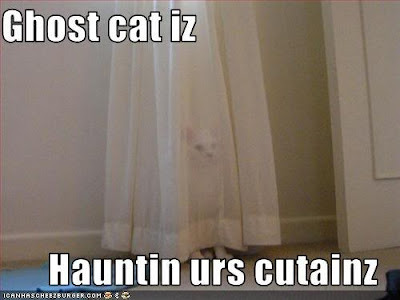 With all of this to contend with, you have to feel sorry for Captain Huntley in his fight against smugglers! Find out how he gets on in "Hope's Betrayal." (Currently a 25% discount on the cover price during July at Smashwords - just enter the code SSW25. http://www.smashwords.com/books/view/163804 )
With all of this to contend with, you have to feel sorry for Captain Huntley in his fight against smugglers! Find out how he gets on in "Hope's Betrayal." (Currently a 25% discount on the cover price during July at Smashwords - just enter the code SSW25. http://www.smashwords.com/books/view/163804 )
Published on July 11, 2012 02:16
July 4, 2012
The Renaissance Betrothal - guest post by Freda Lightfoot.
I'm delighted to welcome author, Freda Lightfoot, to the blog.
Born in Lancashire, Freda has been a teacher, bookseller and, in a mad moment, a smallholder on the freezing fells of the English Lake District where she attempted to live the ‘good life’. She has now given up her thermals to live in an olive grove in Spain, where she produces her own olive oil and sits in the sun. She began her writing career by publishing over 50 short stories and articles, and has published 39 novels including many bestselling family sagas and historical novels.So without further ado, welcome Freda!
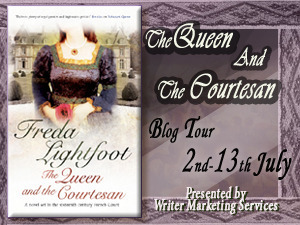 The Renaissance Betrothal. Popular since the Middle Ages, betrothal ceremonies frequently involved some sort of ceremony or symbolic act. This is believed to date back to the time of ancient Rome. In Anglo-Saxon England the joining of hands to seal the betrothal was common as we know from the term ‘handfasting’ to signify a betrothal. In fourteenth and fifteenth century Italy, the betrothal was sealed by a handshake between the parents, or at best the father of the bride and the prospective groom. In sixteenth century France this ritual was known as les accords. There would be the giving of a ring, often a gimmel ring which was in two parts, one to be worn by the prospective groom, the other by the bride, the two joined together to form the wedding ring. Records indicate the drinking of wine to toast the agreement, or taking part in a sumptuous feast ‘in the name of marriage’, or simply be sealed with a kiss.
The Renaissance Betrothal. Popular since the Middle Ages, betrothal ceremonies frequently involved some sort of ceremony or symbolic act. This is believed to date back to the time of ancient Rome. In Anglo-Saxon England the joining of hands to seal the betrothal was common as we know from the term ‘handfasting’ to signify a betrothal. In fourteenth and fifteenth century Italy, the betrothal was sealed by a handshake between the parents, or at best the father of the bride and the prospective groom. In sixteenth century France this ritual was known as les accords. There would be the giving of a ring, often a gimmel ring which was in two parts, one to be worn by the prospective groom, the other by the bride, the two joined together to form the wedding ring. Records indicate the drinking of wine to toast the agreement, or taking part in a sumptuous feast ‘in the name of marriage’, or simply be sealed with a kiss.
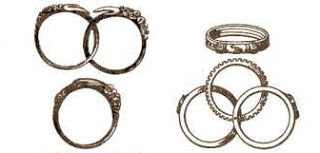 Some examples of antique gimmel rings.The betrothal ceremony confirmed that these two people promised to marry one another, an agreement which could be considered more legally binding than the marriage ceremony itself. Once betrothed, if a couple had sexual intercourse, then they were considered married. And a betrothal contract could only be broken if both parties agreed. Not that the young woman concerned had much say in the matter. Marriage was less about love and more about wealth, position and power, which meant, as we romantic novelists know, plenty of opportunity for extra-curricular activity in the way of affairs. Henry IV is reputed to have enjoyed at least 60 mistresses with whom he sired numerous illegitimate children, and three or four maîtresse-en-titre. But with Henriette de’Entragues he perhaps took on more than he’d bargained for she had set her sights on nothing less than marriage, and with it a crown. She therefore insisted upon a promesse de matrimonio before agreeing to surrender her maidenhead, allegedly still intact, and becoming his mistress. In a weak moment of overwhelming desire, Henry agreed that if she could give him a son, then he would marry her. A decision which was to create untold problems in the years ahead, and leave Henriette fighting a battle for what she perceived as her rights, at whatever the cost.
Some examples of antique gimmel rings.The betrothal ceremony confirmed that these two people promised to marry one another, an agreement which could be considered more legally binding than the marriage ceremony itself. Once betrothed, if a couple had sexual intercourse, then they were considered married. And a betrothal contract could only be broken if both parties agreed. Not that the young woman concerned had much say in the matter. Marriage was less about love and more about wealth, position and power, which meant, as we romantic novelists know, plenty of opportunity for extra-curricular activity in the way of affairs. Henry IV is reputed to have enjoyed at least 60 mistresses with whom he sired numerous illegitimate children, and three or four maîtresse-en-titre. But with Henriette de’Entragues he perhaps took on more than he’d bargained for she had set her sights on nothing less than marriage, and with it a crown. She therefore insisted upon a promesse de matrimonio before agreeing to surrender her maidenhead, allegedly still intact, and becoming his mistress. In a weak moment of overwhelming desire, Henry agreed that if she could give him a son, then he would marry her. A decision which was to create untold problems in the years ahead, and leave Henriette fighting a battle for what she perceived as her rights, at whatever the cost.
 Henriette de'Entragues.
Henriette de'Entragues.
Next came the fiançailles when the bans were published. The parents, bride and bridegroom would visit the curé together to attend to this important matter. Then came the Epousailles which of course took place in church. The bridegroom was not allowed to enter without giving a considerable sum in alms, and guests were chosen to attend the wedding breakfast with an eye to the money they’d be likely to give. A bowl was handed round at dinner into which donations for a ‘nest-egg’ for the couple could be dropped.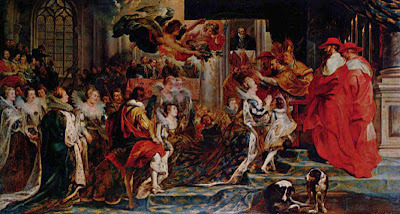 Marie de Medici's wedding.Henry left such traditions to the bourgeoisie, but provided well for all his children, whatever their status, and was a loving father. Those he had with Henriette shared the royal nursery with the legitimate heirs he had with his queen, Marie de Medici, much to that lady’s displeasure. But Henry loved to play with them, and it was so much more practical to keep them all together in one place. The people of Paris were highly entertained by the fact that his mistress and queen were often enceinte at the same time. Thank you so much for you interesting post, Freda. I hugely enjoyed reading "The Queen and the Courtesan" and can heartily recommend it to all lovers of historical fiction.
Marie de Medici's wedding.Henry left such traditions to the bourgeoisie, but provided well for all his children, whatever their status, and was a loving father. Those he had with Henriette shared the royal nursery with the legitimate heirs he had with his queen, Marie de Medici, much to that lady’s displeasure. But Henry loved to play with them, and it was so much more practical to keep them all together in one place. The people of Paris were highly entertained by the fact that his mistress and queen were often enceinte at the same time. Thank you so much for you interesting post, Freda. I hugely enjoyed reading "The Queen and the Courtesan" and can heartily recommend it to all lovers of historical fiction.
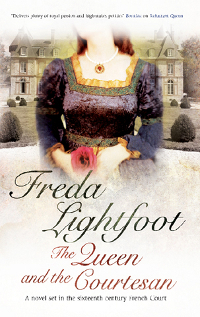 Click for link.
Click for link.
You can find out more about Freda and her work here:The Queen and the Courtesan, published 29 June, can be found as a paperback or ebook herhttp://www.amazon.co.uk/The-Queen-Courtesan-Freda-Lightfoot/dp/1847513972/ref=tmm_pap_title_0?ie=UTF8&qid=1338886284&sr=1-1Most of Freda's titles are now available as ebooks on Amazon, Kobo, Smashwords etc. Links to them can be found here:- http://www.fredalightfoot.co.uk
http://www.fredalightfoot.blogspot.com
Follow Freda on Twitter: @fredalightfootFacebook: http://en-gb.facebook.com/fredalightfoot

Born in Lancashire, Freda has been a teacher, bookseller and, in a mad moment, a smallholder on the freezing fells of the English Lake District where she attempted to live the ‘good life’. She has now given up her thermals to live in an olive grove in Spain, where she produces her own olive oil and sits in the sun. She began her writing career by publishing over 50 short stories and articles, and has published 39 novels including many bestselling family sagas and historical novels.So without further ado, welcome Freda!
 The Renaissance Betrothal. Popular since the Middle Ages, betrothal ceremonies frequently involved some sort of ceremony or symbolic act. This is believed to date back to the time of ancient Rome. In Anglo-Saxon England the joining of hands to seal the betrothal was common as we know from the term ‘handfasting’ to signify a betrothal. In fourteenth and fifteenth century Italy, the betrothal was sealed by a handshake between the parents, or at best the father of the bride and the prospective groom. In sixteenth century France this ritual was known as les accords. There would be the giving of a ring, often a gimmel ring which was in two parts, one to be worn by the prospective groom, the other by the bride, the two joined together to form the wedding ring. Records indicate the drinking of wine to toast the agreement, or taking part in a sumptuous feast ‘in the name of marriage’, or simply be sealed with a kiss.
The Renaissance Betrothal. Popular since the Middle Ages, betrothal ceremonies frequently involved some sort of ceremony or symbolic act. This is believed to date back to the time of ancient Rome. In Anglo-Saxon England the joining of hands to seal the betrothal was common as we know from the term ‘handfasting’ to signify a betrothal. In fourteenth and fifteenth century Italy, the betrothal was sealed by a handshake between the parents, or at best the father of the bride and the prospective groom. In sixteenth century France this ritual was known as les accords. There would be the giving of a ring, often a gimmel ring which was in two parts, one to be worn by the prospective groom, the other by the bride, the two joined together to form the wedding ring. Records indicate the drinking of wine to toast the agreement, or taking part in a sumptuous feast ‘in the name of marriage’, or simply be sealed with a kiss.  Some examples of antique gimmel rings.The betrothal ceremony confirmed that these two people promised to marry one another, an agreement which could be considered more legally binding than the marriage ceremony itself. Once betrothed, if a couple had sexual intercourse, then they were considered married. And a betrothal contract could only be broken if both parties agreed. Not that the young woman concerned had much say in the matter. Marriage was less about love and more about wealth, position and power, which meant, as we romantic novelists know, plenty of opportunity for extra-curricular activity in the way of affairs. Henry IV is reputed to have enjoyed at least 60 mistresses with whom he sired numerous illegitimate children, and three or four maîtresse-en-titre. But with Henriette de’Entragues he perhaps took on more than he’d bargained for she had set her sights on nothing less than marriage, and with it a crown. She therefore insisted upon a promesse de matrimonio before agreeing to surrender her maidenhead, allegedly still intact, and becoming his mistress. In a weak moment of overwhelming desire, Henry agreed that if she could give him a son, then he would marry her. A decision which was to create untold problems in the years ahead, and leave Henriette fighting a battle for what she perceived as her rights, at whatever the cost.
Some examples of antique gimmel rings.The betrothal ceremony confirmed that these two people promised to marry one another, an agreement which could be considered more legally binding than the marriage ceremony itself. Once betrothed, if a couple had sexual intercourse, then they were considered married. And a betrothal contract could only be broken if both parties agreed. Not that the young woman concerned had much say in the matter. Marriage was less about love and more about wealth, position and power, which meant, as we romantic novelists know, plenty of opportunity for extra-curricular activity in the way of affairs. Henry IV is reputed to have enjoyed at least 60 mistresses with whom he sired numerous illegitimate children, and three or four maîtresse-en-titre. But with Henriette de’Entragues he perhaps took on more than he’d bargained for she had set her sights on nothing less than marriage, and with it a crown. She therefore insisted upon a promesse de matrimonio before agreeing to surrender her maidenhead, allegedly still intact, and becoming his mistress. In a weak moment of overwhelming desire, Henry agreed that if she could give him a son, then he would marry her. A decision which was to create untold problems in the years ahead, and leave Henriette fighting a battle for what she perceived as her rights, at whatever the cost.
 Henriette de'Entragues.
Henriette de'Entragues.Next came the fiançailles when the bans were published. The parents, bride and bridegroom would visit the curé together to attend to this important matter. Then came the Epousailles which of course took place in church. The bridegroom was not allowed to enter without giving a considerable sum in alms, and guests were chosen to attend the wedding breakfast with an eye to the money they’d be likely to give. A bowl was handed round at dinner into which donations for a ‘nest-egg’ for the couple could be dropped.
 Marie de Medici's wedding.Henry left such traditions to the bourgeoisie, but provided well for all his children, whatever their status, and was a loving father. Those he had with Henriette shared the royal nursery with the legitimate heirs he had with his queen, Marie de Medici, much to that lady’s displeasure. But Henry loved to play with them, and it was so much more practical to keep them all together in one place. The people of Paris were highly entertained by the fact that his mistress and queen were often enceinte at the same time. Thank you so much for you interesting post, Freda. I hugely enjoyed reading "The Queen and the Courtesan" and can heartily recommend it to all lovers of historical fiction.
Marie de Medici's wedding.Henry left such traditions to the bourgeoisie, but provided well for all his children, whatever their status, and was a loving father. Those he had with Henriette shared the royal nursery with the legitimate heirs he had with his queen, Marie de Medici, much to that lady’s displeasure. But Henry loved to play with them, and it was so much more practical to keep them all together in one place. The people of Paris were highly entertained by the fact that his mistress and queen were often enceinte at the same time. Thank you so much for you interesting post, Freda. I hugely enjoyed reading "The Queen and the Courtesan" and can heartily recommend it to all lovers of historical fiction.
 Click for link.
Click for link.You can find out more about Freda and her work here:The Queen and the Courtesan, published 29 June, can be found as a paperback or ebook herhttp://www.amazon.co.uk/The-Queen-Courtesan-Freda-Lightfoot/dp/1847513972/ref=tmm_pap_title_0?ie=UTF8&qid=1338886284&sr=1-1Most of Freda's titles are now available as ebooks on Amazon, Kobo, Smashwords etc. Links to them can be found here:- http://www.fredalightfoot.co.uk
http://www.fredalightfoot.blogspot.com
Follow Freda on Twitter: @fredalightfootFacebook: http://en-gb.facebook.com/fredalightfoot
Published on July 04, 2012 02:00
June 27, 2012
Did You Know...? - Smuggling #3
 Not that sort of barrell!What links the following items: Prunes, salt, string, soap, paper, black pepper and brandy?
Not that sort of barrell!What links the following items: Prunes, salt, string, soap, paper, black pepper and brandy? The answer is they were all once smuggled goods. In the 18th century it wasn’t just luxury items that were smuggled, but anything in demand that would raise a profit. Indeed, one chapel in Pembrokeshire was lit by candles made of smuggled tallow:"One evening, the chapel being lighted with those candles, by some means… the excise officer became aware…and suddenly appeared and commandeered all the candles, leaving the congregation in the dark."
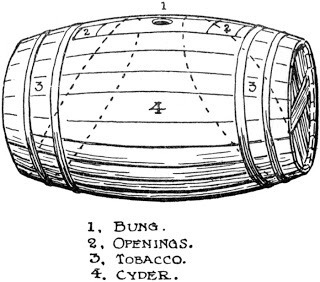 A smuggler's barrell with hidden compartments.In order to maximise the quantity of smuggled goods per run, alcohol and spirits were transported undiluted, straight from the still. This was dangerously strong, and virtually colourless. Dilution to make it drinkable was a relatively simple matter, but no one wanted to buy clear brandy, and so caramel was added to achieve the traditional colour.
A smuggler's barrell with hidden compartments.In order to maximise the quantity of smuggled goods per run, alcohol and spirits were transported undiluted, straight from the still. This was dangerously strong, and virtually colourless. Dilution to make it drinkable was a relatively simple matter, but no one wanted to buy clear brandy, and so caramel was added to achieve the traditional colour. Undiluted spirits were drinkable but potentially lethal. When a smuggler's ship ran aground in shallows near Harwich, they threw their cargo of barrels overboard to lighten the vessel. Soldiers from a nearby fort seized the alcohol and took the opportunity to celebrate - the next day four of them died from alcohol poisoning.
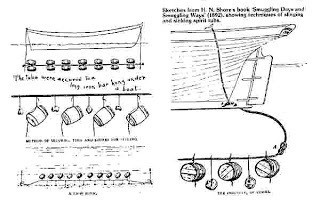 Tubs and barrells were sometimes hidden beneath the boat. Because the alcohol was so concentrated, it could be transported in smaller barrels, or tubs, making it easier for men to carry ashore. The writer Thomas Hardy recalls these tubs in his notebooks."…my grandfather used to do a little smuggling, his house being a lonely one. He sometimes had as many as eighty tubs in a dark closet…the spirits often smelt all over the house, being proof, and had to be lowered for drinking." He goes onto describe a tub and how it became an everyday object.
Tubs and barrells were sometimes hidden beneath the boat. Because the alcohol was so concentrated, it could be transported in smaller barrels, or tubs, making it easier for men to carry ashore. The writer Thomas Hardy recalls these tubs in his notebooks."…my grandfather used to do a little smuggling, his house being a lonely one. He sometimes had as many as eighty tubs in a dark closet…the spirits often smelt all over the house, being proof, and had to be lowered for drinking." He goes onto describe a tub and how it became an everyday object."The tubs …were of thin staves with wooden hoops. I remember one being turned into a bucket by knocking out one head and putting in a handle."Thomas Hardy.
 Modern Calais.It's also interesting to note that many modern French ports owe their development to smuggling. Ports such as Boulogne, Calais, Dieppe and Le Havre were conveniently placed for short crossing from England and had good harbours. They may have started as sleepy fishing ports but as they realised the potential for free-trade and easy money, they transformed themselves into centres of commerce.
Modern Calais.It's also interesting to note that many modern French ports owe their development to smuggling. Ports such as Boulogne, Calais, Dieppe and Le Havre were conveniently placed for short crossing from England and had good harbours. They may have started as sleepy fishing ports but as they realised the potential for free-trade and easy money, they transformed themselves into centres of commerce. "Roscoff…and unknown and unfrequented port…grew in importance so that from small hovels it soon possessed commodius houses and large stores…These….gave every incentive to the British smugglers to resort there and …the French government afforded encouragement to the merchants."
French report, 1767
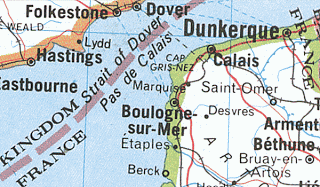
Whilst smuggling may have started small scale, when for instance a draper wished to stock his shop more cheaply, but in the mid 18th century a change took place. Wealthy city backers started financing runs as a form of investment. These men fronted the cash to buy foreign supplies and pocketed the profits, but avoided the physical lifting-and-shifting of smuggling. They were a bit like modern speculators on the futures market, city financiers who weren’t worried about the ethics of their trade.
These wealthy men risked a lot of money and in 'Hope's Betrayal', our villain is just such a man, and when he perceives Hope has betrayed him to Captain Huntley, becomes obsessed with revenge and resolves to destroy what the Captain holds most dear.
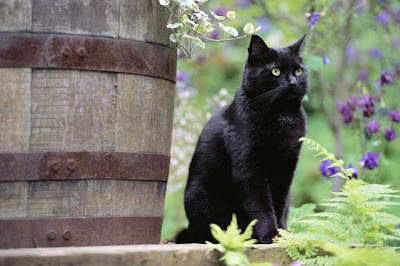 Photo courtesy of Inkity.com
Photo courtesy of Inkity.com
Published on June 27, 2012 02:41
June 24, 2012
Dinner with Mrs Rundel. Welcome to Maria Grace!
Today I'm delighted to welcome author, Maria Grace, to the blog.
Maria has been writing since she was 10, although those early efforts are not for public consumption! She has one husband, two graduate degrees and two black belts, three sons, four undergraduate majors, five nieces, six cats, seven Regency-era fiction projects and notes for eight more writing projects in progress. To round out the list, she cooks for nine in order to accommodate the growing boys and usually makes ten meals at a time so she only cooks twice a month.
So without further ado, a warm welcome to Maria who posts on 19th century dining!
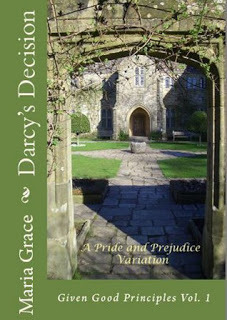 Maria's book has an awesome 4-plus * rating on Goodreads (27 reviews) Dinner with Mrs. Rundel.Oftentimes writers write what they know and I suppose I am no exception. With three teen-aged sons, food can be a big deal. Lots of entertaining and important things happen around the dinner table. So it isn’t surprising that in nearly everything I write I feature at least one important mealtime scene.
Maria's book has an awesome 4-plus * rating on Goodreads (27 reviews) Dinner with Mrs. Rundel.Oftentimes writers write what they know and I suppose I am no exception. With three teen-aged sons, food can be a big deal. Lots of entertaining and important things happen around the dinner table. So it isn’t surprising that in nearly everything I write I feature at least one important mealtime scene.
All this is well and good, except that food, like everything else has changed a great deal in the last two hundred or so years. What constitutes a satisfying meal today looks entirely different from the expectations of the 1800’s. Can anyone say ‘research’? Enter my newest, or should I say oldest, favorite cookbook:
New System of Domestic Cookery: Founded up Principles of Economy; and Adapted to the Use of Private Families
, by Mrs. Maria Eliza Ketelby Rundell (1745-December 16, 1828). ‘Mrs. Rundell’ as it was often referred to, was the most popular English cookbook of the first half of the nineteenth century. The first edition came out in 1806, several later editions were published with additions by other contributors. At the time, few books on domestic management were available. Mrs. Rundel collected tips and recipes for her three daughters out of her thirty years’ experience running her household in Bath. Initially she planned to have four copies made, but Jane Austen’s publisher got involved and the rest is, as they say, history.
Enter my newest, or should I say oldest, favorite cookbook:
New System of Domestic Cookery: Founded up Principles of Economy; and Adapted to the Use of Private Families
, by Mrs. Maria Eliza Ketelby Rundell (1745-December 16, 1828). ‘Mrs. Rundell’ as it was often referred to, was the most popular English cookbook of the first half of the nineteenth century. The first edition came out in 1806, several later editions were published with additions by other contributors. At the time, few books on domestic management were available. Mrs. Rundel collected tips and recipes for her three daughters out of her thirty years’ experience running her household in Bath. Initially she planned to have four copies made, but Jane Austen’s publisher got involved and the rest is, as they say, history.
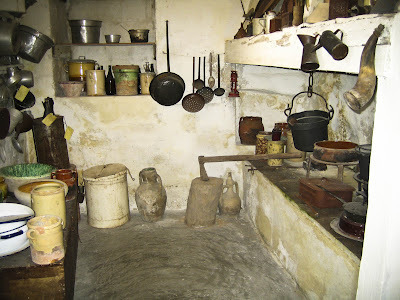
For anyone interested, replica editions have been published and the original itself is available free on line:http://digital.lib.msu.edu/projects/cookbooks/html/books/book_03.cfm or
http://books.google.com/books/about/A_new_system_of_domestic_cookery.html?id=H3UEAAAAYAAJWith Mrs. Rundel’s assistance I learned a great deal about both food and domestic concerns in the early 1800’s. Who would have guessed stale white bread was good for cleaning wallpaper?Just as cleaning methods changed, what foods are served for a meal have changed as well. For dinner I might serve a lasagna, green salad and dinner rolls or corn salad, roast broccoli and mushrooms, Peloponnesian pot roast and barley pilaf. Not so our ancestors. A whole host of unfamiliar dishes and meal plans awaited me in the pages so generously penned by Mrs. Rundel.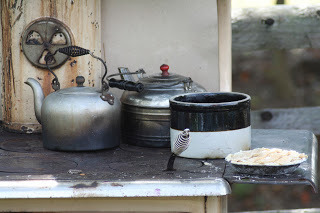
Her final chapter contains dinner plans for family dinners. For us, dinner consists of three or four dishes, she starts at five and works her way up very quickly, all the way up to two courses of eleven dishes plus removes. (Removes were dishes that were replaced with something else part way through the course). I have to admit, the thought makes my head swim. For a big holiday dinner with all the relatives coming, I might make eight dishes, not including dessert, which I try to have someone else bring. Twenty two to twenty four dishes and you might just need to lock me up in a room with very soft walls!The contents of Mrs. Rundel’s menus were also very heavy on the meat dishes. For example, a five course meal might include: Half Calf's Head, grilled, (Remove and replace with Pie or Pudding.)Tongue and Brains, Carrot Soup, Greens round bacon, Saddle of Mutton, and Potatoes and Salad, at side table. That’s three mean dishes out of the five. Atkins friendly I suppose.
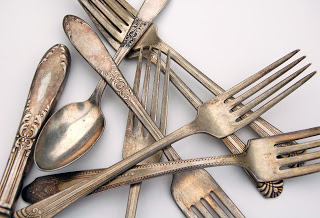 Her most elaborate meal plan, ‘eleven and eleven, and two removes’ just made my head spin. It is hard to imagine how much kitchen staff it would take to accomplish this meal, especially when you take into consideration the lack of refrigeration and other modern conveniences. Notice the mix of dishes too. I would never serve a raspberry tart and lobster and duck all on the same course.FIRST COURSE
Her most elaborate meal plan, ‘eleven and eleven, and two removes’ just made my head spin. It is hard to imagine how much kitchen staff it would take to accomplish this meal, especially when you take into consideration the lack of refrigeration and other modern conveniences. Notice the mix of dishes too. I would never serve a raspberry tart and lobster and duck all on the same course.FIRST COURSE
Salmon, (Remove and replace with Brisket of Beef stewed, and high Sauce,) Cauliflower, Fry,
Shrimp Sauce, Pigeon Pie, Stewed Cucumbers, Giblet Soup, Stewed Peas and Lettuce, Potatoes, Cutlets Maintenon, Anchovy Sauce, Veal Olives braised, Soles fried. (Remove and replace with Quarter Lamb roasted.)
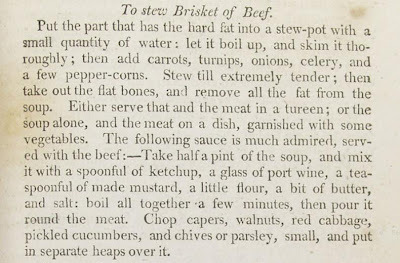
SECOND COURSE
Young Peas, Coffee Cream, Ramakins, Lobster, Raspberry Tart, Trifle, Orange Tourt,
Grated Beef, Omlet, Roughed Jelly, Ducks.
Mrs. Rundel kindly includes recipes for many, though not all of these dishes. (I cannot for the life of me figure out what ‘Fry’ is.) A few of them are rather interesting. I am not sure how many of these are going to show up on my dinner table. But I may just try the Stewed Cucumbers one of these days.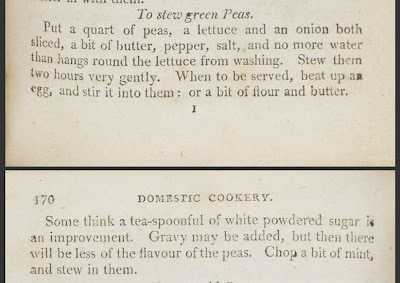
Some of these dishes make appearances in my Given Good Principles series. The first book, Darcy’s Decision was released in January and is available on Amazon.com. The second, Darcy’s helpmate (or possibly The Future Mrs. Darcy —indecision is taking its toll on me right now!) will be released in July. The final volume, Principles and Virtue is slated for release at the end of 2012.
And in case you’d like to know what Peloponnesian Pot Roast
2.5-3 lb pot roast
24 oz. tomato sauce
2 T vinegar
1 t ground nutmeg
½ t ground cinnamon
½ t ground all spice.
Brown meat in heavy pot. Mix remaining ingredients and pour over roast. Simmer 1 ½ hours, until cooked through. Alternatively, cook in a crock pot, 3-4 hours high, 6-8 hours low.

Thank you so much, Maria, for a gem of a post - right up my street. The Mrs Rundel book is a real find and one I'm going to check out. Best of luck with your writing - I cannt wait to read 'Darcy's Decision' - it has some awesome reviews on Goodreads!
Grace x
Darcy's Decision - the story.
Six months after his father's passing, Fitzwilliam Darcy still finds solace in his morning reflections at his parents' graves. Only in the quiet solitude of the churchyard does he indulge his grief. None but his unlikely mentor recognize the heartache and insecurity plaguing him as he shoulders the enormous burden of being Master of Pemberley.
Not all are pleased with his choice of advisor. Lady Catherine complains Darcy allows him too much influence. Lord Matlock argues, "Who is he to question the God-appointed social order?" But the compassionate wisdom Darcy finds in his counselor keeps him returning for guidance even though it causes him to doubt everything he has been taught. In the midst of his struggles to reinvent himself, his school chum, Charles Bingley, arrives. Darcy hopes the visit will offer some respite from the uproar in his life. Instead of relief, Darcy discovers his father's darkest secret staring him in the face. Pushed to his limits, Darcy must overcome the issues that ruined his father and, with his friends and mentor at his side, restore his tarnished birthright. Author, Maria Grace.BUY LINK: http://www.amazon.com/dp/B006VZOSCO
Author, Maria Grace.BUY LINK: http://www.amazon.com/dp/B006VZOSCO
Maria can be contacted at: author.MariaGrace@gmail.com. You can find her profile on Facebook: facebook.com/AuthorMariaGrace or visit her website at AuthorMariaGrace.com

Maria has been writing since she was 10, although those early efforts are not for public consumption! She has one husband, two graduate degrees and two black belts, three sons, four undergraduate majors, five nieces, six cats, seven Regency-era fiction projects and notes for eight more writing projects in progress. To round out the list, she cooks for nine in order to accommodate the growing boys and usually makes ten meals at a time so she only cooks twice a month.
So without further ado, a warm welcome to Maria who posts on 19th century dining!
 Maria's book has an awesome 4-plus * rating on Goodreads (27 reviews) Dinner with Mrs. Rundel.Oftentimes writers write what they know and I suppose I am no exception. With three teen-aged sons, food can be a big deal. Lots of entertaining and important things happen around the dinner table. So it isn’t surprising that in nearly everything I write I feature at least one important mealtime scene.
Maria's book has an awesome 4-plus * rating on Goodreads (27 reviews) Dinner with Mrs. Rundel.Oftentimes writers write what they know and I suppose I am no exception. With three teen-aged sons, food can be a big deal. Lots of entertaining and important things happen around the dinner table. So it isn’t surprising that in nearly everything I write I feature at least one important mealtime scene.All this is well and good, except that food, like everything else has changed a great deal in the last two hundred or so years. What constitutes a satisfying meal today looks entirely different from the expectations of the 1800’s. Can anyone say ‘research’?
 Enter my newest, or should I say oldest, favorite cookbook:
New System of Domestic Cookery: Founded up Principles of Economy; and Adapted to the Use of Private Families
, by Mrs. Maria Eliza Ketelby Rundell (1745-December 16, 1828). ‘Mrs. Rundell’ as it was often referred to, was the most popular English cookbook of the first half of the nineteenth century. The first edition came out in 1806, several later editions were published with additions by other contributors. At the time, few books on domestic management were available. Mrs. Rundel collected tips and recipes for her three daughters out of her thirty years’ experience running her household in Bath. Initially she planned to have four copies made, but Jane Austen’s publisher got involved and the rest is, as they say, history.
Enter my newest, or should I say oldest, favorite cookbook:
New System of Domestic Cookery: Founded up Principles of Economy; and Adapted to the Use of Private Families
, by Mrs. Maria Eliza Ketelby Rundell (1745-December 16, 1828). ‘Mrs. Rundell’ as it was often referred to, was the most popular English cookbook of the first half of the nineteenth century. The first edition came out in 1806, several later editions were published with additions by other contributors. At the time, few books on domestic management were available. Mrs. Rundel collected tips and recipes for her three daughters out of her thirty years’ experience running her household in Bath. Initially she planned to have four copies made, but Jane Austen’s publisher got involved and the rest is, as they say, history.

For anyone interested, replica editions have been published and the original itself is available free on line:http://digital.lib.msu.edu/projects/cookbooks/html/books/book_03.cfm or
http://books.google.com/books/about/A_new_system_of_domestic_cookery.html?id=H3UEAAAAYAAJWith Mrs. Rundel’s assistance I learned a great deal about both food and domestic concerns in the early 1800’s. Who would have guessed stale white bread was good for cleaning wallpaper?Just as cleaning methods changed, what foods are served for a meal have changed as well. For dinner I might serve a lasagna, green salad and dinner rolls or corn salad, roast broccoli and mushrooms, Peloponnesian pot roast and barley pilaf. Not so our ancestors. A whole host of unfamiliar dishes and meal plans awaited me in the pages so generously penned by Mrs. Rundel.

Her final chapter contains dinner plans for family dinners. For us, dinner consists of three or four dishes, she starts at five and works her way up very quickly, all the way up to two courses of eleven dishes plus removes. (Removes were dishes that were replaced with something else part way through the course). I have to admit, the thought makes my head swim. For a big holiday dinner with all the relatives coming, I might make eight dishes, not including dessert, which I try to have someone else bring. Twenty two to twenty four dishes and you might just need to lock me up in a room with very soft walls!The contents of Mrs. Rundel’s menus were also very heavy on the meat dishes. For example, a five course meal might include: Half Calf's Head, grilled, (Remove and replace with Pie or Pudding.)Tongue and Brains, Carrot Soup, Greens round bacon, Saddle of Mutton, and Potatoes and Salad, at side table. That’s three mean dishes out of the five. Atkins friendly I suppose.
 Her most elaborate meal plan, ‘eleven and eleven, and two removes’ just made my head spin. It is hard to imagine how much kitchen staff it would take to accomplish this meal, especially when you take into consideration the lack of refrigeration and other modern conveniences. Notice the mix of dishes too. I would never serve a raspberry tart and lobster and duck all on the same course.FIRST COURSE
Her most elaborate meal plan, ‘eleven and eleven, and two removes’ just made my head spin. It is hard to imagine how much kitchen staff it would take to accomplish this meal, especially when you take into consideration the lack of refrigeration and other modern conveniences. Notice the mix of dishes too. I would never serve a raspberry tart and lobster and duck all on the same course.FIRST COURSESalmon, (Remove and replace with Brisket of Beef stewed, and high Sauce,) Cauliflower, Fry,
Shrimp Sauce, Pigeon Pie, Stewed Cucumbers, Giblet Soup, Stewed Peas and Lettuce, Potatoes, Cutlets Maintenon, Anchovy Sauce, Veal Olives braised, Soles fried. (Remove and replace with Quarter Lamb roasted.)

SECOND COURSE
Young Peas, Coffee Cream, Ramakins, Lobster, Raspberry Tart, Trifle, Orange Tourt,
Grated Beef, Omlet, Roughed Jelly, Ducks.
Mrs. Rundel kindly includes recipes for many, though not all of these dishes. (I cannot for the life of me figure out what ‘Fry’ is.) A few of them are rather interesting. I am not sure how many of these are going to show up on my dinner table. But I may just try the Stewed Cucumbers one of these days.

Some of these dishes make appearances in my Given Good Principles series. The first book, Darcy’s Decision was released in January and is available on Amazon.com. The second, Darcy’s helpmate (or possibly The Future Mrs. Darcy —indecision is taking its toll on me right now!) will be released in July. The final volume, Principles and Virtue is slated for release at the end of 2012.
And in case you’d like to know what Peloponnesian Pot Roast
2.5-3 lb pot roast
24 oz. tomato sauce
2 T vinegar
1 t ground nutmeg
½ t ground cinnamon
½ t ground all spice.
Brown meat in heavy pot. Mix remaining ingredients and pour over roast. Simmer 1 ½ hours, until cooked through. Alternatively, cook in a crock pot, 3-4 hours high, 6-8 hours low.

Thank you so much, Maria, for a gem of a post - right up my street. The Mrs Rundel book is a real find and one I'm going to check out. Best of luck with your writing - I cannt wait to read 'Darcy's Decision' - it has some awesome reviews on Goodreads!
Grace x
Darcy's Decision - the story.
Six months after his father's passing, Fitzwilliam Darcy still finds solace in his morning reflections at his parents' graves. Only in the quiet solitude of the churchyard does he indulge his grief. None but his unlikely mentor recognize the heartache and insecurity plaguing him as he shoulders the enormous burden of being Master of Pemberley.
Not all are pleased with his choice of advisor. Lady Catherine complains Darcy allows him too much influence. Lord Matlock argues, "Who is he to question the God-appointed social order?" But the compassionate wisdom Darcy finds in his counselor keeps him returning for guidance even though it causes him to doubt everything he has been taught. In the midst of his struggles to reinvent himself, his school chum, Charles Bingley, arrives. Darcy hopes the visit will offer some respite from the uproar in his life. Instead of relief, Darcy discovers his father's darkest secret staring him in the face. Pushed to his limits, Darcy must overcome the issues that ruined his father and, with his friends and mentor at his side, restore his tarnished birthright.
 Author, Maria Grace.BUY LINK: http://www.amazon.com/dp/B006VZOSCO
Author, Maria Grace.BUY LINK: http://www.amazon.com/dp/B006VZOSCOMaria can be contacted at: author.MariaGrace@gmail.com. You can find her profile on Facebook: facebook.com/AuthorMariaGrace or visit her website at AuthorMariaGrace.com
Published on June 24, 2012 02:03
June 20, 2012
Would You Break the Law? - Smuggling #2
I love this comment on the character of smugglers: "…a person who…would have been in every respect, an excellent citizen had not the laws of his country made that a crime which nature never meant to be so." Adam Smith
. An Inquiry into the Nature and Causes of the Wealth of Nations 1776.
 Smuggling - the art of concealment? In the 13th century custom houses were concerned with collecting export duties on the wool that made Englandwealthy. It was the 18th century that saw heavy taxation placed on the import of goods - leaving meagre number of officers to enforce collection - hopelessly outnumbered by spirited Englishmen determined to defraud the crown of revenue. In the 18th century smugglers saw themselves not so much as law breakers but 'free traders.' Indeed, such was the sympathy for cheating the crown of tax that whole communities mobilised themselves to unload illegal landings of tobacco, brandy and tea.
Smuggling - the art of concealment? In the 13th century custom houses were concerned with collecting export duties on the wool that made Englandwealthy. It was the 18th century that saw heavy taxation placed on the import of goods - leaving meagre number of officers to enforce collection - hopelessly outnumbered by spirited Englishmen determined to defraud the crown of revenue. In the 18th century smugglers saw themselves not so much as law breakers but 'free traders.' Indeed, such was the sympathy for cheating the crown of tax that whole communities mobilised themselves to unload illegal landings of tobacco, brandy and tea.
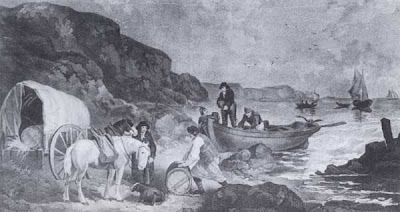
So who were these smugglers? This quote about Niton, Isle of Wight, sheds some light on the answer. "The whole population are smugglers. Everyone has an ostensible occupation, but nobody gets money from it….here are fishermen who never fish…and farmers who farming consists of …standing like herons on look out posts." Sidney Dobell, 1860
Daniel Defoe (author of Robinson Crusoe) wrote of Lymingtion in 1724; "I do not find they have any commerce, except smuggling and roguing, which… is the reigning commerce of all this part of the English coast."
 Celebrated author, Daniel Defoe.It seems everyone was either involved with the illegal importing of foreign goods, or the purchasing of them, as John Wesley recounts of St.Ives.
Celebrated author, Daniel Defoe.It seems everyone was either involved with the illegal importing of foreign goods, or the purchasing of them, as John Wesley recounts of St.Ives.
"well-nigh one and all bought and sold uncustomed goods."
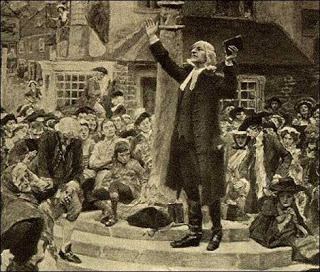 John Wesley had plenty of opportunity for observing those around him.Those involved in the illegal trade were not just shady characters or poor fishermen, but stretched to doctors, clerics and even rich aristocrats in search of excitement. The Rev. Forbes Phillips in his book "The Romance of Smuggling" tells a story of one of his predecessors at the vicarage. Apparently one visitor to the parish spotted illegal activity on the shore and cried out,
John Wesley had plenty of opportunity for observing those around him.Those involved in the illegal trade were not just shady characters or poor fishermen, but stretched to doctors, clerics and even rich aristocrats in search of excitement. The Rev. Forbes Phillips in his book "The Romance of Smuggling" tells a story of one of his predecessors at the vicarage. Apparently one visitor to the parish spotted illegal activity on the shore and cried out,
"Smuggling! Oh, the shame of it! Is there no magistrate to hand, no justice of the peace? Is there no clergyman, no minister?" The naïve visitor's protests were silenced when the locals pointed out it was the vicar holding the lantern.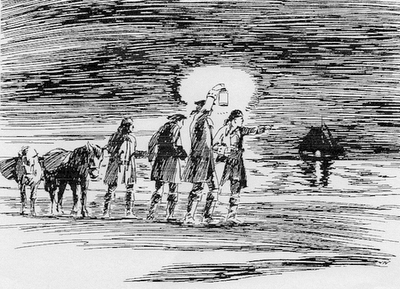 Smugglers on-shore, awaiting the arrival of their load.Of course the incentive for taking part in, or turning a blind eye to, smuggling was financial. At a time when everything from salt to silk, and tea to tobacco was taxed, cutting out the governments share meant people might be able to afford a little comfort in their lives. Such was the way of the world back then, that a little casual handling of illegal goods was looked on as common place, as in this diary entry by Parson Woodforde. "Andrews the smuggler brought me this night about 11 o'clock a bag of Hyson Tea, 6 lb weight. He frightened us a little by whistling under the parlour window just as we were going to bed. I gave him some Geneva(gin) and paid for the tea at 10/6 a lb."
Smugglers on-shore, awaiting the arrival of their load.Of course the incentive for taking part in, or turning a blind eye to, smuggling was financial. At a time when everything from salt to silk, and tea to tobacco was taxed, cutting out the governments share meant people might be able to afford a little comfort in their lives. Such was the way of the world back then, that a little casual handling of illegal goods was looked on as common place, as in this diary entry by Parson Woodforde. "Andrews the smuggler brought me this night about 11 o'clock a bag of Hyson Tea, 6 lb weight. He frightened us a little by whistling under the parlour window just as we were going to bed. I gave him some Geneva(gin) and paid for the tea at 10/6 a lb."
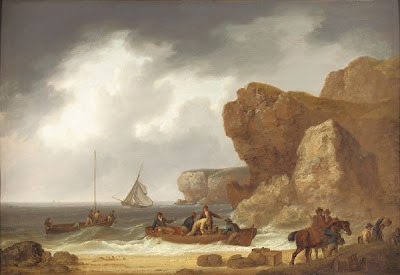 Smuggled goods being transported ashore.
Smuggled goods being transported ashore.
In Hope's Betrayal, our heroine Hope Tyler, turns to smuggling as a means of supporting her ailing father. So the question is, would you break the law if all around you were doing the same, and is it acceptable to defraud the government? Do share you thoughts and leave a comment.
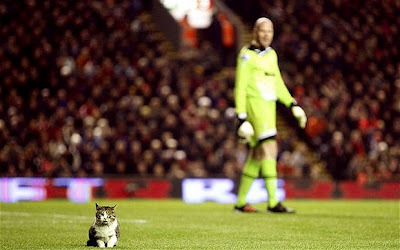 How do you smuggle a cat into a football stadium?
How do you smuggle a cat into a football stadium? 
 Smuggling - the art of concealment? In the 13th century custom houses were concerned with collecting export duties on the wool that made Englandwealthy. It was the 18th century that saw heavy taxation placed on the import of goods - leaving meagre number of officers to enforce collection - hopelessly outnumbered by spirited Englishmen determined to defraud the crown of revenue. In the 18th century smugglers saw themselves not so much as law breakers but 'free traders.' Indeed, such was the sympathy for cheating the crown of tax that whole communities mobilised themselves to unload illegal landings of tobacco, brandy and tea.
Smuggling - the art of concealment? In the 13th century custom houses were concerned with collecting export duties on the wool that made Englandwealthy. It was the 18th century that saw heavy taxation placed on the import of goods - leaving meagre number of officers to enforce collection - hopelessly outnumbered by spirited Englishmen determined to defraud the crown of revenue. In the 18th century smugglers saw themselves not so much as law breakers but 'free traders.' Indeed, such was the sympathy for cheating the crown of tax that whole communities mobilised themselves to unload illegal landings of tobacco, brandy and tea.

So who were these smugglers? This quote about Niton, Isle of Wight, sheds some light on the answer. "The whole population are smugglers. Everyone has an ostensible occupation, but nobody gets money from it….here are fishermen who never fish…and farmers who farming consists of …standing like herons on look out posts." Sidney Dobell, 1860
Daniel Defoe (author of Robinson Crusoe) wrote of Lymingtion in 1724; "I do not find they have any commerce, except smuggling and roguing, which… is the reigning commerce of all this part of the English coast."
 Celebrated author, Daniel Defoe.It seems everyone was either involved with the illegal importing of foreign goods, or the purchasing of them, as John Wesley recounts of St.Ives.
Celebrated author, Daniel Defoe.It seems everyone was either involved with the illegal importing of foreign goods, or the purchasing of them, as John Wesley recounts of St.Ives."well-nigh one and all bought and sold uncustomed goods."
 John Wesley had plenty of opportunity for observing those around him.Those involved in the illegal trade were not just shady characters or poor fishermen, but stretched to doctors, clerics and even rich aristocrats in search of excitement. The Rev. Forbes Phillips in his book "The Romance of Smuggling" tells a story of one of his predecessors at the vicarage. Apparently one visitor to the parish spotted illegal activity on the shore and cried out,
John Wesley had plenty of opportunity for observing those around him.Those involved in the illegal trade were not just shady characters or poor fishermen, but stretched to doctors, clerics and even rich aristocrats in search of excitement. The Rev. Forbes Phillips in his book "The Romance of Smuggling" tells a story of one of his predecessors at the vicarage. Apparently one visitor to the parish spotted illegal activity on the shore and cried out,"Smuggling! Oh, the shame of it! Is there no magistrate to hand, no justice of the peace? Is there no clergyman, no minister?" The naïve visitor's protests were silenced when the locals pointed out it was the vicar holding the lantern.
 Smugglers on-shore, awaiting the arrival of their load.Of course the incentive for taking part in, or turning a blind eye to, smuggling was financial. At a time when everything from salt to silk, and tea to tobacco was taxed, cutting out the governments share meant people might be able to afford a little comfort in their lives. Such was the way of the world back then, that a little casual handling of illegal goods was looked on as common place, as in this diary entry by Parson Woodforde. "Andrews the smuggler brought me this night about 11 o'clock a bag of Hyson Tea, 6 lb weight. He frightened us a little by whistling under the parlour window just as we were going to bed. I gave him some Geneva(gin) and paid for the tea at 10/6 a lb."
Smugglers on-shore, awaiting the arrival of their load.Of course the incentive for taking part in, or turning a blind eye to, smuggling was financial. At a time when everything from salt to silk, and tea to tobacco was taxed, cutting out the governments share meant people might be able to afford a little comfort in their lives. Such was the way of the world back then, that a little casual handling of illegal goods was looked on as common place, as in this diary entry by Parson Woodforde. "Andrews the smuggler brought me this night about 11 o'clock a bag of Hyson Tea, 6 lb weight. He frightened us a little by whistling under the parlour window just as we were going to bed. I gave him some Geneva(gin) and paid for the tea at 10/6 a lb."
 Smuggled goods being transported ashore.
Smuggled goods being transported ashore.In Hope's Betrayal, our heroine Hope Tyler, turns to smuggling as a means of supporting her ailing father. So the question is, would you break the law if all around you were doing the same, and is it acceptable to defraud the government? Do share you thoughts and leave a comment.
 How do you smuggle a cat into a football stadium?
How do you smuggle a cat into a football stadium?
Published on June 20, 2012 02:26
June 14, 2012
Welcome! Guest authors Bill and Susan Hayes.
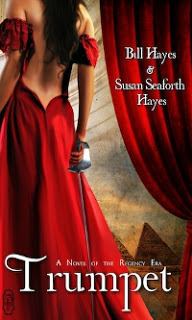
A warm welcome to husband-and-wife writing team Bill and Susan Hayes. I'm delighted to have you visit today. Please do share a little about yourselves by way of an introduction. Bill and Susan Hayes have been professional entertainers all their lives. They appeared together on the cover of Times Magazine representing soap opera in 1976, and are still on Days of Our Lives the forty seven year old daytime drama. Bill and Susan Hayes .com is our website if you wish to examine our past. In the present our double memoir Like Sands Through the Hourglass was published in 2005, and we just released our first novel for Decadent Publishing. Bill has BA in Music and English and a Doctorate in Education. Susan began acting professionally at age four.
 Susan and Bill Hayes.
Susan and Bill Hayes.I understand you have a new release, "Trumpet" , please tell us a little about the book.Trumpet is a historical novel, telling the story of a young girl’s journey to maturity through the world of English theater and beyond. Ambitiously the tale begins in 1803 and closes in 1821. We took our heroine Elizabeth Trumpet to the heights of fame and the disasters of loss, filling every page with our own extensive life experience. The most exciting and colorful persons of the age are interwoven with the fictional characters, keeping true to historical events. We personally visited the sites of her story, London, Italy, Egypt, Waterloo’s battlefield and the city of Charleston. For the past seven years research has been our middle name. That sounds wonderful, I think visiting the locations adds such depth to a story. What aspect of the book are you most pleased with? It’s a large canvas, yet it reads colorfully and easily, with enough spice to make your heart race. We always strive to inject humor, and feel there is a perfect combination of laughter and tears. Our goal is to make our readers enter a far away world, yet experience emotions true to the human heart. Sounds like just my sort of escapist read! How did you feel when you first learnt that Trumpet was to be published? Joyful. It was such a great chunk of our lives and marriage, we plunged into the last rewrite with furious pleasure. Creating Lizzie Trumpet’s world has bonded Hayes and Hayes even closer than our onscreen romance on NBC, as Doug and Julie. We highly recommend such a project for any relationship that needs to deepen intimacy, There is a lot of competition for readers’ attention these days. What do you think singles out your book so that people will want to read it? Profound parallels to the struggles of our lives today. A grinding war with no end in sight, the distressing failing of a beloved parent, the many steps and missteps on the way in a career for young women; these are some of the conflicts we threw at our heroine. We mixed in two of the most compelling lovers anywhere, one of whom was a real giant in history as well as the bedroom. Dare I say we have the inside track on knowing about the lives of actors from a rather rich experience? Yes, we do. What is the best and the worst thing about writing historical fiction? Do you find some aspects more enjoyable than others? We drew a passel of characters from our backstage lives and read every word of dialogue aloud with each other until it danced on the page. Pure pleasure. Pin pointing point of view was not nearly as much fun It seems eBooks are taking off in a big way. What is your opinion on eBooks vs. traditional paperbacks? Bill loves to grasp a good bound book, but is peering into his little Nook every night with equal devotion. Susan says the wider the audience the better. E books are so reasonably priced, she sees their charm Tell me, Bill and Susan, if you need to escape from the cares of the world, how do you relax?Open a volume of Patrick O'Brian. Take a driving trip to anywhere. Go to the opera. Plan a journey to somewhere in Italy. Have a See’s chocolate. What is the kindest act anyone has ever done for you?Well lets see, Susan says “When Bill asked to marry me. That was big. And I still appreaciate it.” Bill says “When Susan said, “OK!” (Awh, so sweet! G )What would your nearest and dearest say is your most annoying habit? Susan is neat. More neat than accurate. Bill sings continually. On pitch too. Have you heard of ‘Room 101’ – the room where an object once placed disappears forever…I wish all alarm clocks went there! What 5 things would you put in Room 101 and why? Nuclear warheads. Skin heads. Bed bugs. Throw rugs. Wet slugs. I feel further explanations unnecessary. It’s been lovely chatting with you both, and before you go, where can we find out more about Trumpet?Those who have read Trumpet, say they hated to see it end, because it was so much fun. Writing it was like planning a party for our dearest friends. Everything we love is in those pages. Dear readers, open Trumpet and have a wonderful time.
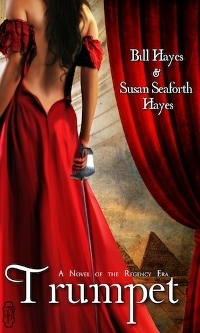
SYNOPSIS.
Brilliant and sassy Elizabeth Trumpet fantasizes starring on the Londonstage, but to become an actress in 1803 is tantamount to losing her virginity in the most debasing way.After watching her mother die and her father lose his mind, the courageous sixteen-year-old must find a way to save her family. She scores her first acting job as a fencer—the deadly skill she learned from her brother training for the military. Blessed with talent and a rare singing voice, Lizzie pursues her career, learning from theatrical characters high and low.When reckless actor Jonathan Faversham sets eyes on Miss Trumpet, he knows he’s found the partner of his life. But Faversham carries ruinous baggage from a dark past. Entangled in lust and ambition, Lizzie gives him her heart and they reach the heights together. Until Lizzie gets more applause than he…From the magnificence of Regency palaces and the Theatre Royal Covent Garden to the sun-baked pyramids of Egypt and the arms of a real-life Samson, Lizzie is never far from trouble. As her brother rides to glory with Wellingtonin the Napoleonic Wars, great events threaten her survival. Danger lurks behind stage curtains, when a madman sets fire to take her life and she lifts a sword in revenge.Will this once innocent girl, with her rise to stardom, be remembered for her art? Or for her shame?Trumpet is published by Decadent Publishing, and is available from Amazon UK, Amazon US, All Romance eBooks, Smashwords and all other good eBook retailers.*****COMMENT TO WIN!Bill and Susan are generously giving away two prizes on this tour! One is their double memoir, Like Sands Through the Hourglass, and the second is Bill's CD, This is Bill Hayes. Just leave a comment (please include your email address in the body of the comment) on this post to be entered. This giveaway is tour wide, and the more comments you leave, the more chance you have of winning, so check out the rest of the tour schedule here: http://www.writermarketing.co.uk/prpromotion/blog-tours/currently-on-tour/bill-susan-hayes/
Published on June 14, 2012 23:13
'Familiar Felines.'
Following on from last weeks Halloween posting, today's blog post looks at the unwanted image of cats as the witches familiar - from the Norse Goddess Freya to lonely women in the middle ages.
The full Following on from last weeks Halloween posting, today's blog post looks at the unwanted image of cats as the witches familiar - from the Norse Goddess Freya to lonely women in the middle ages.
The full post can found at:
http://graceelliot-author.blogspot.com
...more
The full Following on from last weeks Halloween posting, today's blog post looks at the unwanted image of cats as the witches familiar - from the Norse Goddess Freya to lonely women in the middle ages.
The full post can found at:
http://graceelliot-author.blogspot.com
...more
- Grace Elliot's profile
- 156 followers



